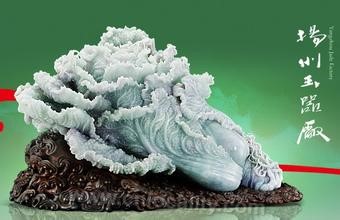welcomeSpecialty Foods Products!

Yangzhou is one of the important bases for jade processing in China, and there is a description of "Yangzhou Gongyaokun" in the ancient book "Book of Songs and Yugong". In 1977, more than 60 clan public tombs in the late Neolithic period were found in Weilu, Shugang, Yangzhou, including stone axes, stone spears, jade bi, jade cong and other artifacts, indicating that our ancestors had been producing and living here as early as 4,000 years ago, and had jade pondering activities. Among more than 100 Han tombs discovered and cleared in Yangzhou after liberation, hundreds of jade articles with dozens of varieties were unearthed. Yangzhou's jade carving technology has a long history, and the ancient book "Book of Songs and Yu Gong Pian" has the descriptions of "Yong Zhou Gong Linlang" and "Yangzhou Gong Yao Kun", which traces the history of jade carving in Yangzhou back to the Xia Dynasty 4,000 years ago. Although Yangzhou referred to in Yu Gong Pian was a state of "Kyushu in the World" at that time, its historical origin can be proved. In 1977, more than 60 clan public tombs in the late Neolithic period were found in Weilu, Shugang, Yangzhou, including stone axes, stone spears, jade bi, jade cong and other artifacts, indicating that as early as 4,000 years ago in the Xia Dynasty, ancestors produced and lived here and had jade carving activities. Among more than 100 Han tombs discovered and cleared in Yangzhou after liberation, hundreds of jade articles with dozens of varieties were unearthed. In the Tang Dynasty, Yangzhou carved jade, which had a new development in the prosperity of handicraft industry. Noble giants decorated pavilions with jade pieces, so-called "carved jade households". In Tang Xizong, Gao Pian, the history of salt and iron, built a "Royal Building" in Yangzhou, and made hundreds of thousands of pieces of dragons and phoenixes with golden jade to decorate them. Gao Pian also presented tens of thousands of pieces of Yangzhou jade jewelry that had been searched for many years to the imperial court. In the Tang Dynasty, jade articles were worn by the people, and ornaments gradually became popular. In the Song Dynasty, Yangzhou jade has developed into furnishings, with increasingly rich varieties of flowers, birds, stoves and bottles, and the artistic level of modeling and pondering has been greatly improved. During the reign of Emperor Qianlong in Qing Dynasty, jade carving in Yangzhou entered its heyday. Nearly 10 large jade mountains weighing 1,000 kg and 10,000 kg in the Qing Palace were mostly carved by Yangzhou, among which the Jade Mountain, which weighs more than 10,000 kg and is called the "King of Jade", has become a rare treasure and is famous far and wide.
Reprinted with attribution:
https://cnlocality.com/(Chinese Specialty Products)
other
consult:(+86)13225231905